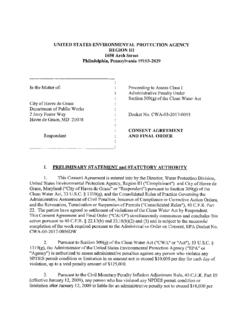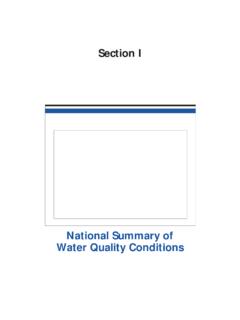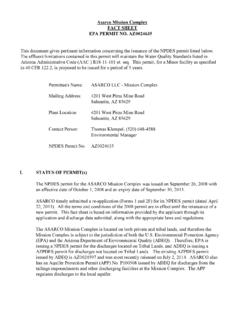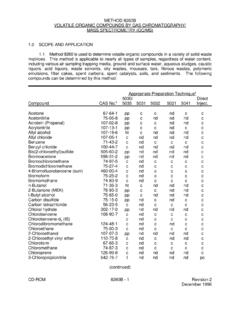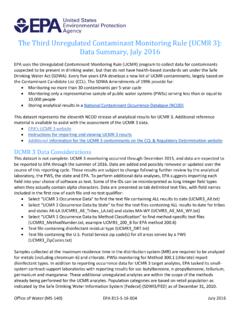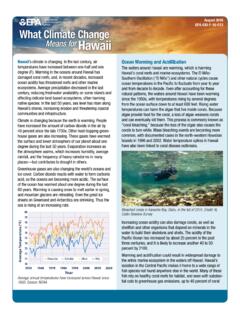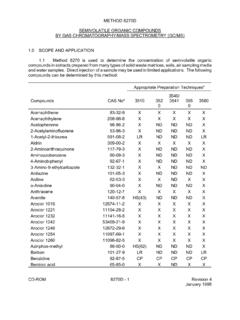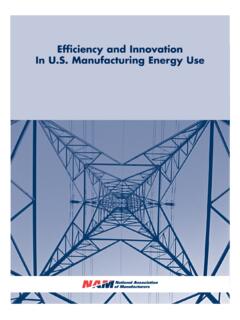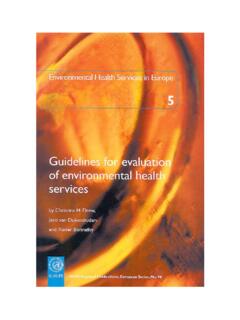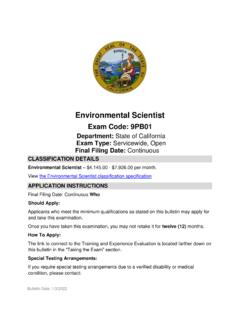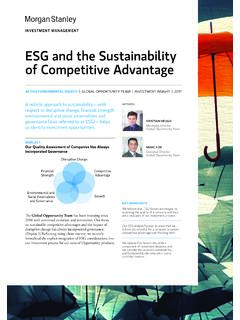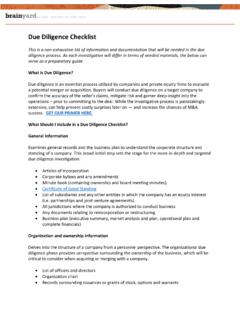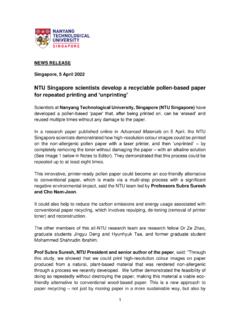Transcription of CONFIGURATION MANAGEMENT PROCEDURE - United …
1 Page 1 of 10 EPA Classification No.: CIO CIO Approval Date: 06/10/2013 CIO Transmittal No.: 13-003 Review Date: 06/10/2016 Issued by the EPA Chief Information Officer, Pursuant to Delegation 1-84, dated June 7, 2005 CONFIGURATION MANAGEMENT PROCEDURE 1 PURPOSE The purpose of this PROCEDURE is to describe the process EPA Program Offices and Regions must follow to comply with the environmental Protection Agency s (EPA or Agency) CONFIGURATION MANAGEMENT Policy. 2 SCOPE AND APPLICABILITY This PROCEDURE is applicable to all of EPA s Enterprise hardware, software, and applicable documentation that might impact EPA network performance, operations and security. Hardware and software used for specialty or scientific purposes that are disconnected from the EPA network do not fall under the scope of this PROCEDURE . 3 AUDIENCE The primary audience for the CONFIGURATION MANAGEMENT PROCEDURE includes all EPA personnel in roles that are directly responsible for the CONFIGURATION , MANAGEMENT , oversight, and successful day-to-day operations of EPA Enterprise hardware, software and applicable documentation.
2 4 BACKGROUND CONFIGURATION MANAGEMENT is an Information Technology Infrastructure Library (ITIL) IT Service MANAGEMENT (ITSM) process to manage and control the baselines and configurations of an organization s Enterprise hardware, software, and applicable documentation. Industry standards, including those issued by the Government accounting Office (GAO) and the Office of MANAGEMENT and Budget (OMB), and several National Institute of Standards and Technology (NIST) Federal Information Processing Standards (FIPS) and Special Publications (SP), stress that information systems ( , general support systems, major applications, and minor applications) must document and assess the potential impact that proposed system changes may have on the operational processes and security posture of the system. IT industry best practices recognize CONFIGURATION MANAGEMENT as an essential aspect of effective system MANAGEMENT . CONFIGURATION MANAGEMENT consists of 4 main tasks: Identification this is the specification of all IT components ( CONFIGURATION items) and their inclusion in a CONFIGURATION MANAGEMENT Database (CMDB) Control this is the MANAGEMENT of each CONFIGURATION item, specifying who is authorized to change it Status this is the recording of the current condition of all CONFIGURATION items in the CMDB, and the maintenance of this information Verification this is the review and audit of the information contained in the CMDB to ensure it is accurate Page 2 of 10 EPA Classification No.
3 : CIO CIO Approval Date: 06/10/2013 CIO Transmittal No.: 13-003 Review Date: 06/10/2016 A CONFIGURATION item is an IT asset or a combination of IT assets that may depend on and have relationships with other IT processes. CONFIGURATION MANAGEMENT involves tracking all of the individual CONFIGURATION items in an IT system in a CMDB. Information contained in the CMDB includes: Hardware Software Documentation Personnel The CMDB can be comprised of a multitude of different types of CONFIGURATION items, each containing various attributes, and is used to document CONFIGURATION item relationships and track their CONFIGURATION . A CONFIGURATION item will have attributes which may be hierarchical and relationships that will be assigned by the CONFIGURATION Manager in the CMDB. Appendix A lists some attributes that can be used to assist with identifying the type and level of data a Program Office or Region may consider useful.
4 5 AUTHORITY EPA s CONFIGURATION MANAGEMENT Policy, June 10, 2013 6 RELATED DOCUMENTS Capability Maturity Model Integration for Development, Version , November 2010 Carnegie Mellon, Software Engineering Institute Electronic Industries Alliance 649, National Consensus Standard for CONFIGURATION MANAGEMENT , August 1998 National Institute of Standards and Technology (NIST) Special Publication 800-12 (An Introduction to Computer Security; the NIST Handbook), October 1995 Office of MANAGEMENT and Budget (OMB) Circular No. A-130, MANAGEMENT of Federal Information Systems, November 2000 Office of MANAGEMENT and Budget (OMB) Circular A-123, MANAGEMENT s Responsibility for Internal Control, June 1995 National Institute of Standards and Technology (NIST) Special Publication 800-53 (Recommended Security Controls for Federal Information Systems), May 2010 EPA System Life Cycle MANAGEMENT Policy, CIO , September 21, 2012 EPA System Life Cycle MANAGEMENT PROCEDURE , CIO 2121-P-03.
5 0, September 21, 2012 EPA Information Security Policy, CIO , August 6, 2012 Office of MANAGEMENT and Budget (OMB) Memorandum M-07-18, Ensuring New Acquisitions Include Common Security Configurations, June 1, 2007 Office of MANAGEMENT and Budget (OMB) Memorandum M-08-22, Guidance on the Federal Desktop Core CONFIGURATION (FDCC), August 11, 2008 7 CONFIGURATION MANAGEMENT PROCEDURE In accordance with EPA s CONFIGURATION MANAGEMENT Policy, Program Offices and Regions, in Page 3 of 10 EPA Classification No.: CIO CIO Approval Date: 06/10/2013 CIO Transmittal No.: 13-003 Review Date: 06/10/2016 collaboration with the Office of environmental Information, Office of Technology Operations and Planning, must document, implement, and maintain CONFIGURATION MANAGEMENT processes. CONFIGURATION MANAGEMENT processes include properly identifying CONFIGURATION items, controlling changes, and recording the change implementation status of the physical and functional characteristics of the IT infrastructure.
6 This ensures the overall integrity of the EPA Enterprise. This process is accomplished through implementation of the five tenets of CONFIGURATION MANAGEMENT : CONFIGURATION Planning and MANAGEMENT CONFIGURATION Identification CONFIGURATION Change MANAGEMENT CONFIGURATION Status accounting CONFIGURATION Verification and Audits CONFIGURATION PLANNING AND MANAGEMENT Program Offices and Regions must develop a strategy to define the scope and objectives of a CONFIGURATION MANAGEMENT process as well as identify CONFIGURATION items that shall be tracked within the CMDB. They should also collectively decide, in collaboration with the Office of environmental Information, Office of Technology Operations and Planning, which attributes of CONFIGURATION items are necessary for distinguishing between CONFIGURATION items. When deciding what level of attribute to record it is important to remember the frequency at which the data will be used, by whom it will be used, and what value can be placed on it, together with the cost and effort involved in maintaining it.
7 CONFIGURATION IDENTIFICATION Program Offices and Regions must identify candidate system components, items, and data that will be placed under CONFIGURATION control and MANAGEMENT . This encompasses the following: Identification of applicable CONFIGURATION items Establishment of baselines for control; maintenance of versions and revisions Identification of approved CONFIGURATION documentation of the physical and functional characteristics of the item or system Creation of records in the CMDB Provision of documentation for CONFIGURATION MANAGEMENT and external audits MANAGEMENT of CONFIGURATION item document library in CMBD CONFIGURATION items should be managed throughout the system development life cycle in order to establish and maintain the integrity of the IT product or service. Appendix B lists what Program Offices and Regions can classify as CONFIGURATION items for information systems. CONFIGURATION CHANGE MANAGEMENT Program Offices and Regions must implement a controlled change process and provide tailored methods Page 4 of 10 EPA Classification No.
8 : CIO CIO Approval Date: 06/10/2013 CIO Transmittal No.: 13-003 Review Date: 06/10/2016 and standard operating procedures for effectively planning, recording, controlling, and validating product requirements and data that contain the requirements. Tailoring will depend on the organization and the level of control or complexity needed. CONFIGURATION MANAGEMENT control is accomplished by utilizing the CMDB, a centralized CONFIGURATION MANAGEMENT database, or a series of databases that provide central, logical access to CONFIGURATION data, containing relevant information such as the CONFIGURATION items and their attributes, baselines, documentation, changes, and relationships. Requests for Changes must be stored in the CMDB. CONFIGURATION STATUS accounting The CMDB tool must be used to track submitted Requests for Changes. The objectives of the system are to provide enhanced coordination, visibility, and accountability.
9 Records describing CONFIGURATION items must be established and maintained in the CMDB. The tool must assign a unique identifier to each Request for Change and maintain a repository of all change requests. Program Offices and Regions must record actions in sufficient detail that the content and status of each CONFIGURATION Item is known and previous versions can be recovered. Organizations must maintain product description records, CONFIGURATION verification records, change status records, and history of change approvals. The CMDB must contain relevant information about CONFIGURATION items, their attributes, baselines, documentation, changes, and relationships. The recording of changes must include: The reason for the changes If a proposed change to the CONFIGURATION item is accepted, a schedule for incorporating the change into the CONFIGURATION item and other affected areas Indication that changed CONFIGURATION items have been released only after review and approval of CONFIGURATION changes.
10 Changes are not official until they are approved CONFIGURATION VERIFICATION AND AUDITS CONFIGURATION auditing must be performed by Program Offices and Regions to verify the integrity of the processes, systems, items, and baselines under CONFIGURATION MANAGEMENT control. The CONFIGURATION Manager conducts these audits to ensure baseline compliance of the configured assets hardware, software, and controlled documentation with established requirements, specifications, and functional parameters. Change control processes are also subject to CONFIGURATION MANAGEMENT Audits. Additionally, CONFIGURATION MANAGEMENT Audits must be used to ensure the accuracy of the CMDB; address the effectiveness of the Change Advisory Board; determine the accuracy and completeness of CONFIGURATION MANAGEMENT processes; verify data and documentation; and ensure project compliance with requirements, standards, and conventions. All audit records and respective deficiencies must be placed into the CMDB, which shall be used to track corresponding action items, suspense dates, and close-out activities.

